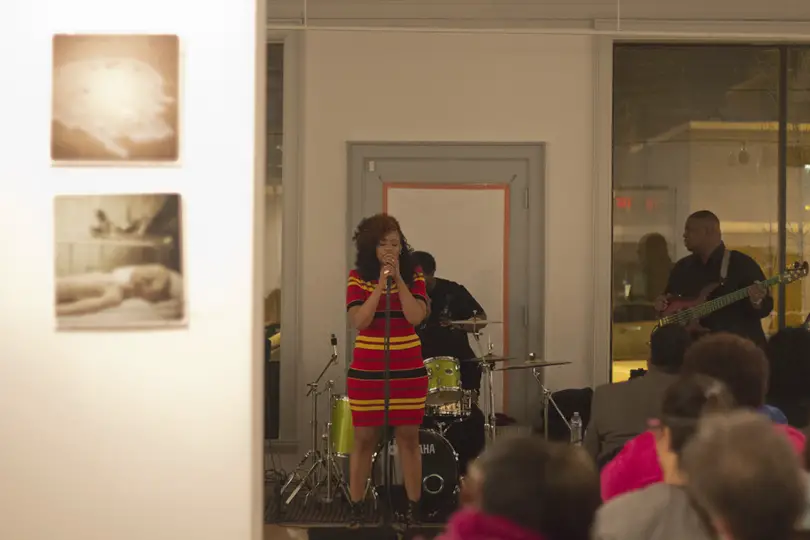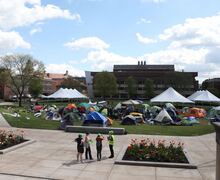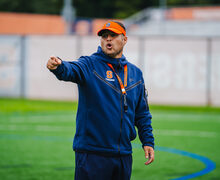Community Folk Art Center features African culture
Kheli Willetts didn’t earn her Ph.D. to teach college students — she got a Ph.D. to learn about art.
It’s the reason why Willetts, the executive director of the Community Folk Art Center, enjoys being surrounded by art and culture every day.
“I feel really lucky to have a very different day every single day, and know that when I walk into that gallery space, every couple of weeks it’s going to look totally different,” Willetts said. “Everything is always different.”
The Community Folk Art Center, which is a unit of the African American Studies Department at Syracuse University, is a multidisciplinary art center that highlights and promotes artists of the African diaspora.
“We’re trying to make sure that we diversify the creative landscape and fill blanks in on information,” Willetts said. “Sometimes it’s a lot easier to get someone to understand the concept when they are being educated through a visual experience.”
CFAC features multiple studio spaces for ceramics, dance and theater, and after-school programs such as the Creative Arts Academy for local Syracuse students in grades 7–12 during the summer.
The center, located on East Genesee Street, also threw a kickoff concert on Friday to commence Black History Month.
CFAC was established in 1972 by an African American studies professor who supported local artists at SU and by students who saw the need for such a space, said Tamar Smithers, director of education at CFAC. The center is also one of the oldest and longest continually running African institutions that is affiliated with the university.
At the Black History Month Kickoff Concert, CFAC featured an up-and-coming R&B artist, Lydia Caesar. Opening for her was one of the local Creative Arts Academy students, Brandyn Thomas.
“He’s an aspiring recording artist,” Smithers said. “It’s great for him to open up and to show how we cultivate young and aspiring artists at the center.”
Smithers also believes the history of the program is what sets CFAC apart.
“We’ve been around 40-plus years. It creates a great avenue for, not just students studying African American history, but for students throughout the campus to be able to come to the center and be made aware of the different cultures,” Smithers said.
In order to appeal to the entire community, Willetts, the executive director, makes sure the exhibits are relatable for everyone.
“For us the point is that we are an inclusive organization, not an exclusive organization,” Willetts said. “So when we do exhibitions in general, we take it from a diaspora approach, not simply just African diaspora.”
For example, when CFAC had an exhibition on Islamic art and culture, it integrated both the Quran and Mandarin as part of the exhibit, Willetts said. The exhibition was not necessarily just about being Muslim and Middle Eastern — it was about being a Muslim in general.
“It’s about the global spread of culture, because what we find is that we ultimately have more in common than we don’t,” Willetts said. “We look at it in terms of creative production and how we find things beautiful — everyone wants their ceramics to be beautiful no matter where they are. That’s what we’re trying to do.”
The center aims to share with diverse communities socioeconomically, racially, culturally and through countries of origin, Willetts added. It also strives to ensure that people from varied backgrounds “see themselves and find themselves” in the center.
“What we’re trying to do for our constituents is not only expose them to amazing art by African descended people,” Willetts said. “But as well as people from Latino, Asian and other cultures who have created art and have had experiences that can be very much identified with people of African descent.”
Although the center is part of the AAS department, it functions under a 501c3, making it a nonprofit organization. It operates independently as a nonprofit through outside funding and can write grants.
CFAC also hosts a cappella groups, classes and workshops that are available during the day and allows dance teams to practice in the space without charging students.
“What we like to do is barter,” Willetts said. “‘Sure, you can use the space — don’t you want to come help out at the next exhibition?’ Some of those kids out there don’t even work here. They just want to be here.”
CFAC will continue its exhibits and programming throughout the month of February without a strict emphasis on Black History Month, said Kishi Ducre, the chair of the African American studies department. Due to counterprogramming across other departments on campus, Ducre believes there is already a lot going on.
Said Ducre: “The irony is that we don’t do much during Black History Month because we do it all year long.”
Published on February 1, 2015 at 11:01 pm
Contact Kait: [email protected]






